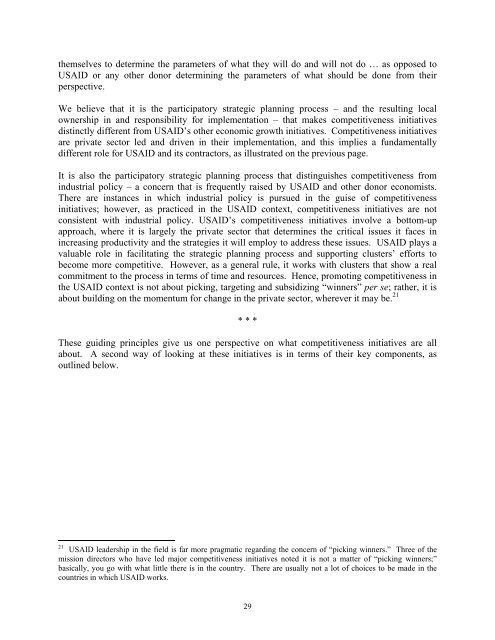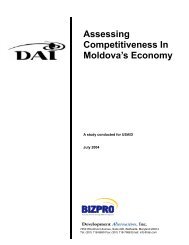Promoting Competitiveness in Practice - Economic Growth - usaid
Promoting Competitiveness in Practice - Economic Growth - usaid
Promoting Competitiveness in Practice - Economic Growth - usaid
Create successful ePaper yourself
Turn your PDF publications into a flip-book with our unique Google optimized e-Paper software.
themselves to determ<strong>in</strong>e the parameters of what they will do and will not do … as opposed to<br />
USAID or any other donor determ<strong>in</strong><strong>in</strong>g the parameters of what should be done from their<br />
perspective.<br />
We believe that it is the participatory strategic plann<strong>in</strong>g process – and the result<strong>in</strong>g local<br />
ownership <strong>in</strong> and responsibility for implementation – that makes competitiveness <strong>in</strong>itiatives<br />
dist<strong>in</strong>ctly different from USAID’s other economic growth <strong>in</strong>itiatives. <strong>Competitiveness</strong> <strong>in</strong>itiatives<br />
are private sector led and driven <strong>in</strong> their implementation, and this implies a fundamentally<br />
different role for USAID and its contractors, as illustrated on the previous page.<br />
It is also the participatory strategic plann<strong>in</strong>g process that dist<strong>in</strong>guishes competitiveness from<br />
<strong>in</strong>dustrial policy – a concern that is frequently raised by USAID and other donor economists.<br />
There are <strong>in</strong>stances <strong>in</strong> which <strong>in</strong>dustrial policy is pursued <strong>in</strong> the guise of competitiveness<br />
<strong>in</strong>itiatives; however, as practiced <strong>in</strong> the USAID context, competitiveness <strong>in</strong>itiatives are not<br />
consistent with <strong>in</strong>dustrial policy. USAID’s competitiveness <strong>in</strong>itiatives <strong>in</strong>volve a bottom-up<br />
approach, where it is largely the private sector that determ<strong>in</strong>es the critical issues it faces <strong>in</strong><br />
<strong>in</strong>creas<strong>in</strong>g productivity and the strategies it will employ to address these issues. USAID plays a<br />
valuable role <strong>in</strong> facilitat<strong>in</strong>g the strategic plann<strong>in</strong>g process and support<strong>in</strong>g clusters’ efforts to<br />
become more competitive. However, as a general rule, it works with clusters that show a real<br />
commitment to the process <strong>in</strong> terms of time and resources. Hence, promot<strong>in</strong>g competitiveness <strong>in</strong><br />
the USAID context is not about pick<strong>in</strong>g, target<strong>in</strong>g and subsidiz<strong>in</strong>g “w<strong>in</strong>ners” per se; rather, it is<br />
about build<strong>in</strong>g on the momentum for change <strong>in</strong> the private sector, wherever it may be. 21<br />
* * *<br />
These guid<strong>in</strong>g pr<strong>in</strong>ciples give us one perspective on what competitiveness <strong>in</strong>itiatives are all<br />
about. A second way of look<strong>in</strong>g at these <strong>in</strong>itiatives is <strong>in</strong> terms of their key components, as<br />
outl<strong>in</strong>ed below.<br />
21 USAID leadership <strong>in</strong> the field is far more pragmatic regard<strong>in</strong>g the concern of “pick<strong>in</strong>g w<strong>in</strong>ners.” Three of the<br />
mission directors who have led major competitiveness <strong>in</strong>itiatives noted it is not a matter of “pick<strong>in</strong>g w<strong>in</strong>ners;”<br />
basically, you go with what little there is <strong>in</strong> the country. There are usually not a lot of choices to be made <strong>in</strong> the<br />
countries <strong>in</strong> which USAID works.<br />
29
















